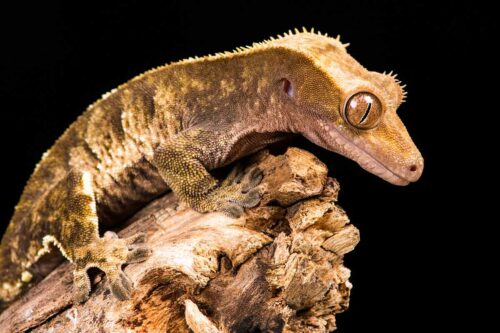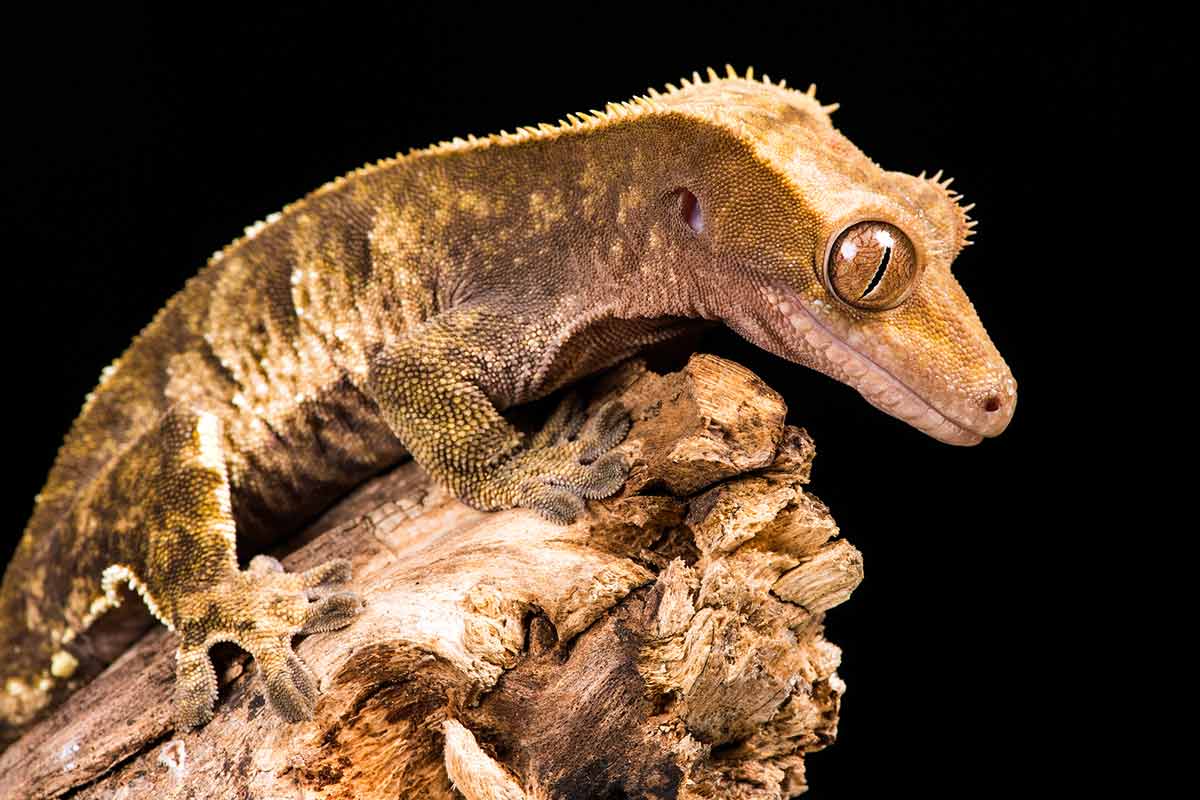If you have a beautiful crested gecko at home, you no doubt want to give them a highly nutritious diet that will keep them healthy and happy. For cresties, this should include lots of fresh fruit, and variety is the spice of life!
But some fruits offer more nutritional value to your crestie than others, and there are some fruits that can actually be dangerous, especially if fed on a regular basis.
Read on for our complete guide to the best fruits to feed your crestie, fruits they can have occasionally, and others that should be avoided.

We’ll also talk about when you should be feeding your crested gecko, how much they should eat, and all the essential elements of a well-rounded diet for a crested gecko.
What Do Crested Geckos Eat In The Wild?
In the wild, crested geckos are omnivorous, which means they eat a bit of everything. In their natural habitat, they have access to insects, fruits, and vegetables.
Their preferred insects tend to be crickets, grasshoppers, roaches, and spiders. As they are nocturnal animals, they will hunt this prey at night.
Crested geckos come from tropical conditions, where their preferred fruits are papayas, mangos, and bananas. They usually wait until fruits are overripe before digging in. Wild crested geckos will also dine on tree sap and nectar.
What Should Crested Geckos Eat In Captivity?
The best diet for a crested gecko in captivity should closely imitate what they eat in the wild. A combination of live insects and fruits, often served in puree form, are often the preferred diet for pet cresties at home.
For an adult crested gecko, they should be given five to seven live crickets or roaches every other day, which can be fed to them directly with a pair of insect tongs.
It’s best to source your insects from breeders or start breeding your own feeder insects. Insects that are caught in the wild often carry parasites and diseases that can harm your crestie.
All lizards need lots of calcium to maintain their health, and it’s extremely difficult for them to get this in captivity.
This is why insects should be dusted with a combined calcium and vitamin D3 powder before feeding to give your crestie a much-needed calcium boost.
The vitamin D3 is essential, since without it, your gecko cannot use the calcium in their system. Since cresties are nocturnal, they aren’t getting their vitamin D3 from the sun and instead need to get it from dietary sources.
Try this top recommended Zoo Med Repti Calcium with D3 Reptile Supplement for dusting.
In addition to this, they can be given a quarter cup of fruit two to four times a week. Many crestie parents choose to mash fruit into a puree to make it easier for their lizard to eat.
But you can also cut it into small pieces. When doing this, pieces should be no bigger than the space between your crested gecko’s eyes, to ensure it doesn’t become a choking hazard.
There are some pre-mix fruit solutions available for reptile pets that you could feed to your crested gecko, but these are not generally recommended. This is because they tend to be generic for all reptiles rather than optimized specifically for cresties.
Also, crested geckos have only been raised in captivity for a few decades, and there is still disagreement over the best diet for these animals when kept as pets. So, it’s a good idea to procure your own fresh fruit for your crestie so you have control over what they eat.
Best Fruits To Feed Your Crested Gecko
The best fruits for crested geckos are soft varieties that are relatively high in calcium and low in phosphorus.
Why is this so important?
Crested geckos need lots of calcium to maintain their bones and scales, and for females to lay their eggs. They need to eat foods that are high in calcium, and this is why it’s recommended that you dust their food with calcium powder.
But phosphorus leeches calcium from the body, so even if a fruit is high in calcium, if it’s also high in phosphorus, it can leave them with less of what they need rather than more.
For geckos, you should look for fruits that have a 2:1 calcium-to-phosphorus ratio or better.
Fruits with oxalic acid are also best avoided because the acid compounds with minerals, such as magnesium and calcium, to form oxalates, which can be dangerous to your crested gecko because it can inhibit calcium and can lead to the formation of kidney stones.
So, with those considerations in mind, what fruits can be on the feeding list for your crested gecko?
The best fruits with a 2:1 or better calcium to phosphorus ratio include:
- Papaya
- Fig
- Prickly pear
- Raspberry
That is a pretty limited list, and crested geckos need variety in their diet to ensure they’re getting all the vitamins and minerals they need.
The following are fruits you can feed to your crested gecko in smaller quantities as they have a 1.5:1 or 1:1 ratio of calcium to phosphorus:
- Blueberries
- Blackberries
- Strawberries
- Grapes
- Apples
- Pears
- Melons
- Cherries
Mangos and bananas do not have the best calcium-to-phosphorus ratio, but these are still worth including in your crested gecko’s diet as they eat them regularly in the wild. It’s just important to ensure these are balanced out with other high-calcium and low-phosphorus foods.
Fruits Crested Geckos Can’t Eat
While there are lots of fruits that your crested gecko can enjoy, there are many they shouldn’t eat. This is why it’s best to stick to the fruits on the approved list and avoid experimentation.
Fruits with too much phosphorus should be avoided as they can leach calcium from your lizard’s system and leave them deficient.
This can result in metabolic bone disease, which can lead to bone breaks, deformities, and eventually death. For this reason, avoid:
- Peaches
- Cantaloupe
- Plums
- Pumpkin
- Pomegranate
- Starfruit
- Passion fruit
Fruits with high concentrations of oxalic acid, such as rhubarb, should also be avoided.
Citrus fruits are also best avoided because they are high in vitamin C, which can cause diarrhea and leave your crested gecko dehydrated, and also high in oxalic acid, which can cause a number of problems.
This means that oranges should be off the menu despite having a good calcium-to-phosphorus ratio. Also avoid lemons, kiwis, pineapples, and grapefruits.
One final fruit that you should never give your crested gecko is avocado. This is because it’s rich in persin, which can be toxic to many animals including crested geckos, even in small amounts. A high enough dose can lead to death within 24 hours.
This is not the only food that’s toxic to cresties—they also can’t have a wide variety of vegetables such as garlic, onion, and eggplant. Soybeans and meats are also off the menu, and spices common in human foods can wreak havoc on their system.
As a general rule, never feed a crested gecko human food. Put together a diet that’s designed to meet their nutritional needs.
Not sure what kind of lizard to adopt? Read our guide to the best reptiles for beginners.
When To Feed Your Crested Gecko
Since crested geckos are nocturnal, they should be fed in the evening, about an hour after they wake up and start to become active.
When they are babies, in the first two months of their lives, they should be fed every day. During this period, they also don’t need insects, just fruit. They should be allowed to eat as much as possible within a 15-20 minute window, and the food should then be taken away.
When they are in the juvenile stage from around two to 18 months, they can be fed a little less often. But at this point, they need a mix of insects and fruits.
They can be fed four to five insects dusted with calcium twice a week, and a quarter of a cup of fruit three times a week.
Once they are fully grown adults, you only need to give your crestie insects twice a week and fruit twice a week.
Again, let them eat as much fruit as they want within a 15-20 minute window and then take the rest away. They can have six to seven crickets on an insect day.
While you don’t want to leave them hungry on a regular basis, you can leave them without food for up to two weeks when necessary.
Fruit For Crested Geckos FAQs
What is a crested gecko’s favorite food?
While crested geckos eat a bit of everything, their favorite food is a live, crunchy insect, especially crickets and roaches. In the wild, catching one of these is considered a good day’s work, and they will be more than happy to munch on them in captivity.
Some cresties develop a taste for mealworms in captivity, and their high fat content means they’re very tasty.
But crested geckos do not eat these in the wild and they don’t have much nutritional value. So, while your lizard may enjoy mealworm, it’s best avoided.
Do crested geckos eat every night?
While your crested gecko might like to eat every night, this is unnecessary and could lead to excessive weight gain. Adult crested geckos only need to eat four times a week, or every other day. Meals should alternate between live insects and small bowls of fruit.
How often should I mist my crested gecko?
While crested geckos don’t drink water, they do need to stay hydrated. The best way to do this is to mist their tank and let them absorb the liquid through their skin.
This needs to be done twice a day for at least 30 seconds to ensure they’re getting enough moisture. The overall humidity of their tank should also be kept at around 50-70%.
How often should I clean my crested gecko’s tank?
Your crestie will thrive in a clean environment, so it’s a good idea to spot clean their terrarium daily and remove any waste. A thorough cleaning of the tank is usually only required once a month.
Fruit Shopping For Your Crestie
As with most animals, including humans, your crested gecko can eat a lot of different things, but some things are good, healthy options, others have limited nutritional value but are OK, and some (usually the most delicious) are downright toxic.
When fruit shopping for your crested gecko, make a list of the healthiest and safest types for your reptile companion and stick to it.
While diversity and experimenting can be fun, you can inadvertently hurt your crestie if you feed them something toxic or with too much phosphorus, which can lead to calcium deficiency.
Your crestie probably is not a picky eater, and if you stick to foods that imitate what they eat in the wild, they will not only be healthy but also very happy.
You can read all of our articles about geckos and how to take care of them here.
- Can Guinea Pigs Eat Potatoes? Foods To Avoid - September 24, 2023
- Can Guinea Pigs Eat Carrots? Feeding Advice - September 23, 2023
- How To Make A DIY Bearded Dragon Enclosure - September 22, 2023

